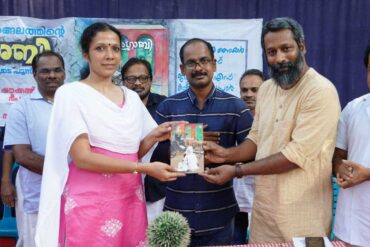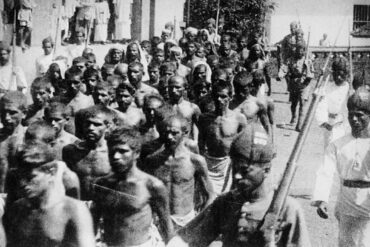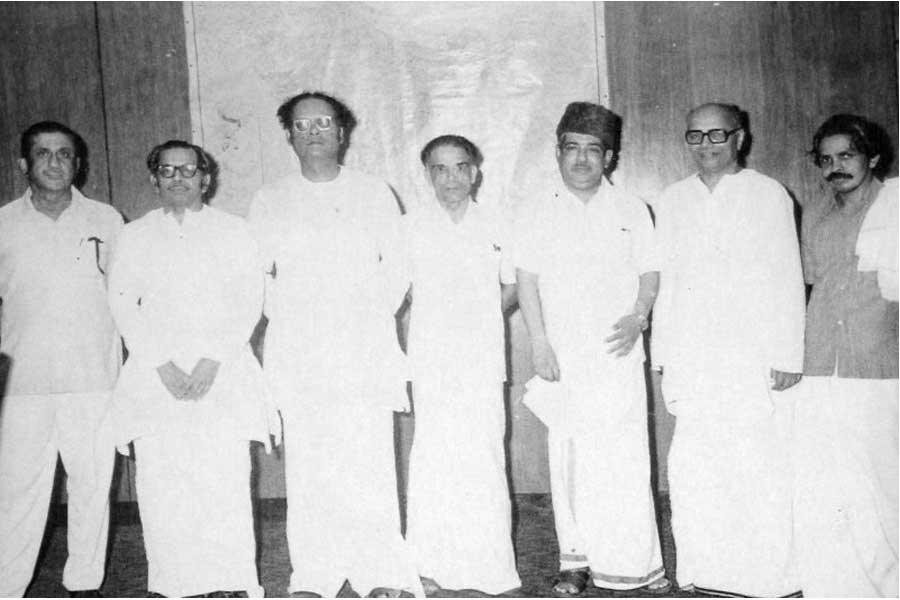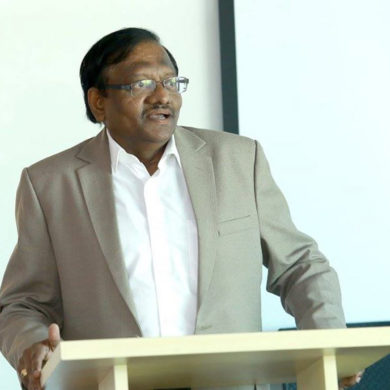Read Part One: The History of Indian Union Muslim League
Muslim League Politics in Post-Independence Days: Part Two
For the first three decades of its existence, the Muslim League made some significant gains in the state’s constantly evolving politics as a crucial element in alliance politics; but these gains were often short-lived. When Communist Party of India’s P K Vasudevan Nair quit as Chief Minister in 1979, League’s C H Mohammad Koya took over the reins but he couldn’t continue for more than two months.
The party remained cocooned in its regional comfort zone, its leaders as well as the rank and file obsessed with local politics. Things took a different turn in the eighties, when national and global issues began to influence them. There were tremendous changes taking place everywhere, and as a community tuned to its global Ummah, or the Muslim brotherhood, the party could not afford to ignore these new challenges. The first of these challenges came in the push for reforms within the community. The second were threats from the outside world.
The Supreme Court verdict in Shah Bano case, and the movement for protection of Muslim Personal Law, as defined by the conservative sections, brought back national concerns to the centre stage. In Parliament as well as in the newly constituted national Muslim platform—All India Muslim Personal Law Board—League leaders like Ebrahim Sulaiman Sait and G M Banatwala were very active. Leaders in the pro-CPI M) All India Muslim League (AIML) found themselves in a difficult situation—the CPI (M) had changed its position vis a vis Muslim communalism and was eager to distance itself from AIML on matters like Islamic Sharia and the rights of Muslim women.
EMS Namboodiripad took an aggressive tone on these matters, to the great disappointment of AIML leaders. They were left with no option but to leave the Left Front, and on 18 July, 1985, they announced the decision to quit the Left Front and sit in the Assembly as a separate block. Then it was only a matter of time for the unification of both factions—formalised at a rally in Calicut on 16 August.
The return of unity in the Muslim League almost coincided with the emergence of factionalism in the CPM, again over the issue of relations with Muslim League. This started with what is known as an alternative policy document, produced by a group of CPM leaders led by M V Raghavan, its firebrand leader from Kannur. It argued that left parties, on their own, could not win or retain power in the state and hence the strategic necessity for adjustments or alliances with parties like Muslim League and/or Kerala Congress, who represented the minorities.
This alternative approach was fiercely opposed by leaders like EMS and V S Achuthanandan, for political as well as personal reasons. Soon, Raghavan and followers were thrown out of the party. They were subjected to a series of political and physical attacks; once again, it was the League which gave Raghavan a helping hand offering him the Azhikode Assembly seat from their quota in the 1987 election. This sort of strategic magnanimity has been the hallmark of Muslim League: In 1995, when A K Antony, who became chief minister on the resignation of K Karunakaran, needed a safe seat to enter Assembly, the League offered him its stronghold of Tirurangadi in Malabar.
The results of the 1987 election and the subsequent elections have produced certain trends in Kerala politics—of deep concern to minorities as well as to secular-minded parties and individuals. Among them is the emergence of a strong right-wing Hindutva politics, as a third force in the state’s political landscape. Such forces were always there, in the form of Bharatiya Jan Sangh and other groups, but they were not able to gain sizable support in the Hindu community or make any impact on electoral politics. But the BJP and its allies were able to garner around 8 per cent votes in the 1987 elections, which rose to as much as 15 percent in the 2016 Assembly elections after stagnating in between. In the 2019 Lok Sabha elections, the BJP retained its support base and improved substantially in half a dozen seats.
Most writers on Kerala’s political history have accepted that matters connected with caste, community and identity determined its course in the post-Independence period. Democratic pretensions apart, it was this patronage system based on such affinities that proved enduring. The only time this entrenched gang-up was put to test was in 1957-59, but the government could not survive the combined assault of these forces. Later on, the Communists themselves adopted these methods and skillfully used caste, community affiliations and feelings to ensure victory.
EMS Namboodiripad, in an article published in Social Scientist in November 1977, accepted this as a fact. He said though caste and communal considerations were not paramount, such factors evidently weighed in while selection of candidates and other practical matters were decided, even in the Communist Party. But this is only an understatement; the influence of caste and community considerations went further and deeper and it engulfed every aspect of political life, including elevation to leadership positions.
The Muslim League was placed in a position to play the communal card in Kerala politics. Except for a brief period in 1980s, when the CPI (M) took a conscious effort to distance itself from parties representing sectarian interests, it has been wooed by all of Kerala’s mainstream political parties. Unlike the fifties and sixties when Congress party was unwilling to have open alliances with League, by the seventies Muslim League had emerged as the second most powerful force in their political front. On the left, CPM also realised it would not be able to ensure continuity of power without its support, this despite the enthusiasm generated by the 1987 electoral victory for the LDF without any alliance with Muslim League or Kerala Congress.
Hence, the subtle moves by Namboodiripad to rope in Muslim League and Kerala Congress, first made explicit during a speech at Thirunakkara in late eighties, which E K Nayanar, the then chief minister, described as a slip of the tongue. Dr Thomas Isaac, then a young CPI (M) leader, described the official line as follows in a 1991 interview. “The tactical understanding with Muslim League helped Communist party get over the split disability in mid 60s…But by the 70s the tactical understanding with Muslim League had become irrelevant, an impediment to growth, contributing only to the growth of communal forces in Kerala.”(Quoted by Jaideep Nair in his PhD thesis at JNU, New Delhi, submitted in 2014.)
But that seems to be only a partial or partisan reading of a highly complex situation. In fact, many observers have argued that the 1987 electoral strategy of the CPI (M) was, in effect, a subtle accommodation of the aggressive Hindu right-wing sensibilities with a view to capturing political gains out of it. The election results proved these calculations to be accurate. But the long-term consequences of such a pro-majoritarian approach in a society like Kerala, with its strong minority presence and long-held tradition of communal cooperation and peace, was acutely felt.
Namboodiripad, for example, could see the need for a more broad based, inclusive politics to sustain the Left parties in the changing circumstances. Anyone could see a groundswell of changes taking place in politics, rendering old strategies no longer effective. At the national level, Hindutva politics was on an upsurge, and its main plank was anti-Muslim posturing, based on half-truths or mere fantasies of turning the clock back to correct the historical wrongs. They whipped up anti-Muslim frenzy to consolidate Hindu vote on a communal platform. This, on the other hand, was generating a sense of insecurity and fear psychosis among Muslims, even in Kerala.
At the global level, anti-Muslim tirade was becoming part of mainstream global political rhetoric. This understanding of social change and global politics helped Namboodiripad make use of Saddam Hussein as a propaganda tool to win Muslim votes in District Council elections in January 1991, in the wake of the invasion of Iraq by US forces in Operation Desert Storm. Such developments did have their impact on parties like Muslim League, with divisions emerging in their ranks and leadership. Namboodiripad was trying to make political advantage of the divisions in the League when he described dissident League leader Ebrahim Sulaiman Sait’s deep-rooted religiosity something akin to Gandhi’s own in his Hindu identity. But he was strongly castigated by the dominant faction in CPI (M) and Namboodiripad had to retract his words.
But this need for tactical alliances with forces aligned with Congress-led United Democratic Front (UDF) had been felt across CPI (M) ranks. After the party’s 1991 electoral debacle, Dr. Thomas Isaac made this point explicit, in a dramatic turnaround from his earlier position: “If the LDF is to ensure its hold on the state government of Kerala, for the present there can be no escape from tactical ploys to win over some of the groups or parties from the UDF, however undesirable they be on other counts.” (Kerala Elections 1991: Lessons and non-lessons, EPW, November 23, 1991.) This was a clear admission that the Communist approach of the 80s was no longer tenable and the party had to take into account new forces from the margins, including the newly-assertive identity groups.
There were several factors behind this new, identity-oriented turn to politics, both at local and the global level. At least three factors need some elaboration in its Kerala context. The first was the decline of the international Communist movement and the fall of Socialist Bloc, a process culminated in the 1991 fall of the Soviet Union. This necessitated a search for new political idioms in place of classical leftist politics based on a theory of class antagonism.
The second was the emergence of a new globalised identity for Muslim community, which is often described as a pan-Islamic identity. Such a trend started gaining momentum from the 1979 Islamic revolution in Iran, and became stronger in a number of Asian and African countries. Keeping abreast of all these developments through a strong Malayali Muslim diaspora in the Islamic world had its impact on Kerala society and politics.
A third aspect was the rise of an academic and intellectual discourse which emphasized on identity as a dominant political factor in the late 20th century. This can be seen in the influence wielded by scholars like Samuel Huntington (Clash of Civilizations, 1996) and Edward Said (Orientalism 1978, Culture and Imperialism, 1993), representing the two ends of the spectrum.
At the same time, identity-based politics had sweeping India as a whole. With Mandal politics making waves in north India, caste-based parties like Samajwadi Party and Bahujan Samaj Party (BSP), and splinter Janata Party outfits emerged as strong alternatives. On the other hand, Hindutva politics based on an aggressive Hindu identity also gained strength. The secular credentials of the Congress were simultaneoulsy weakening, with Prime Minister Narasimha Rao turning a blind eye to the kar sevaks’ assault on Babri Masjid.
Such deep rumblings did have their impact on the Muslim League in Kerala. It came in the form of an insistent demand to put pressure on the Congress party to act decisively, which ruled at the centre. As a result, the League working committee at its meeting at Calicut in February 1991 announced the decision to leave Congress-led UDF. But once the June Assembly election was announced and League found no chance of accommodation in the CPI (M)-led Left Democratic Front, they scampered back to the UDF despite loss of face. But Sulaiman Sait and followers continued their anti-Congress line and parted ways with the League. They formed the Indian National League (INL) in 1994 with a pledge to continue their pro-Left political line.
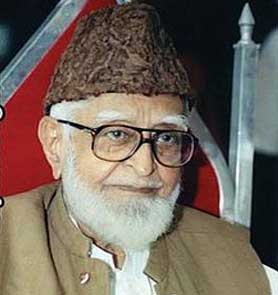
The INL was one of the many political outfits with a Muslim cadre base that appeared in the past quarter century, challenging the hegemony of the Muslim League. The new rivals included parties like the PDP of Abdul Nasir Maudani, the Welfare Party associated with Jama’at-e-Islami Hind and the Social Democratic Party of India (SDPI), connected to the Popular Front of India. They take their inspiration from various Islamist movements active in the Arab & African world and are committed to follow principles of social justice, originally popularised by Mandal parties that became successful in north India. These parties remain in the political periphery in Kerala, but they have the potential to spoil the game for Muslim League in the coming years.
This overview of the seven decades of Muslim League in Kerala brings into focus long periods of mutual accommodation and occasional confrontation between the League and mainstream parties including the Communists. The two-nation theory propounded by Muslim League in the pre-independence days had been sympathetically viewed by Communist Party of India.
In the initial days of the Communist rule in Kerala, while powerful community and caste groups with vested interests in the state were opposed to the government, Muslims initially kept a distance from them, only to join the liberation struggle at a later stage. Even then, the League was careful in attacking government only on political grounds and administrative failures, not couching its resistance in religious terms as the Roman Catholic Church and clergy had done. In fact, the notorious Christopher Sena, a Christian militia, had sprung up with paramilitary activities as early as February 1958 raising highly provocative slogans. Nossiter, in his book Communism in Kerala, quotes from an editorial in Deepika, mouthpiece of the church: “The Chief Minister may not understand the real strength of the Christophers. Five good Christians might be more than sufficient to face even five thousand communists, since…for a true Christian, life on this earth is immaterial.” (page144). To counter this threat, the Communists formed their own paramilitary storm troopers, vitiating the political atmosphere.
The League, however, never indulged in such rhetoric, despite being critical of the Communist rule. There was a strong section of landed gentry and feudal interests in the League leadership who opposed Communists because of concerns like loss of landed property and fears about an empowered working class rising to challenge them. It appears they were able to lead the party into the anti-communist camp, despite a long history of differences between Nair landlords and Muslim tenants in Malabar, as seen in the series of violent incidents culminating in the Mappila rebellion of 1921.
It is an irony of history that this 1959 struggle was to topple a government headed by EMS Namboodiripad, a member of the 1937 Kuttikrishna Menon Committee on Malabar tenancy reforms which called for an end to landlord system, and a writer who argued the Mappila rebellion was a direct outcome of extreme grievances of poor peasants, mostly Muslim, against the upper caste landlords backed by British colonial power.
The experiences of the 1967 government and its fall two years later are helpful to understand the later estrangement of Communists from Muslim League. The CPI (M) was keen to see through land reforms legislation the party considered crucial, while an influential section in the League was not keen about it. When a mini-front was formed within the United Front, initially to resist the CPI (M)’s high-handedness, Chief Minister Namboodiripad made an attempt to drive a wedge in their ranks.
In 1968, he persuaded the CPI (M) State Committee to agree to the formation of Malappuram district, against fierce opposition from various quarters. The League with its Muslim base in the region was its principal beneficiary. Evidently, the Chief Minister expected a return of favour from the League. But on his return from Germany where he had gone for medical treatment, he found the League had ditched him. They joined hands with the Chief Minister’s CPI rivals in the United Front to bring down the government, against the best efforts by then CPI (M) State Secretary A K Gopalan.
The CPI (M) considered the League attitude political treachery and rank opportunism, a point generally supported by scholars like Nossiter and Hardgrave. Like the 1959 decision of the League to join the liberation struggle against the best interests of the social sections that gave it a solid mass base, this move to bring down the United Front government only delayed the long-standing demand for land reforms by the poor peasantry and agricultural workers, a large section of them Muslim.
From a political point of view, the League compulsions to ditch the CPI (M) at the time are difficult to explain. One explanation provided by Nossiter in his analysis is that the League leadership was wary of possible inroads the CPI (M) might make into the community it held under a tight leash. This might be true, because the 1967 EMS Cabinet had some stalwarts from the Muslim community with strong base in Malabar like the veteran E K Imbichi Bava. The rising communist influence among Muslim youth was undeniable and it is possible the League decided to plug the erosion by cutting away the Communist link. Whatever be the truth, ever since breaking away from CPI (M), the League has remained in the opposite camp. And the Muslim League has remained unchallenged in its Malabar stronghold for half a century.
The political implication of the hegemony of League in its Malappuram bastion was twofold. First, it reduced the party into a sub-regional political outfit, controlled by a coterie of individuals with the right connections. Their access to power and privileges was assured, with limited effort, provided they were able to pull the strings. This cosy arrangement with little public accountability and great access to the pleasures of power made the party leaders live in a world of self-indulgence, ignoring the great political rumblings at national and global levels, with Muslims at the receiving end of such upheavals.
It was an undeniable fact that the party did not find even the destruction of Babri Masjid at Ayodhya an event of momentous significance and, that they chose to pull the rug from under the feet of Ebrahim Sulaiman Sait, their national president, who made uncomfortable noises over it.
The second aspect was that this isolationism and sub-regional focus effectively cut the Muslim League away from, and rendered it irrelevant to the changing vicissitudes of Muslim politics in India. There has not been any effort on the part of the League to address the new challenges, or debate how the growing anti-Muslim paranoia with tacit state support might impact upon the community’s future.
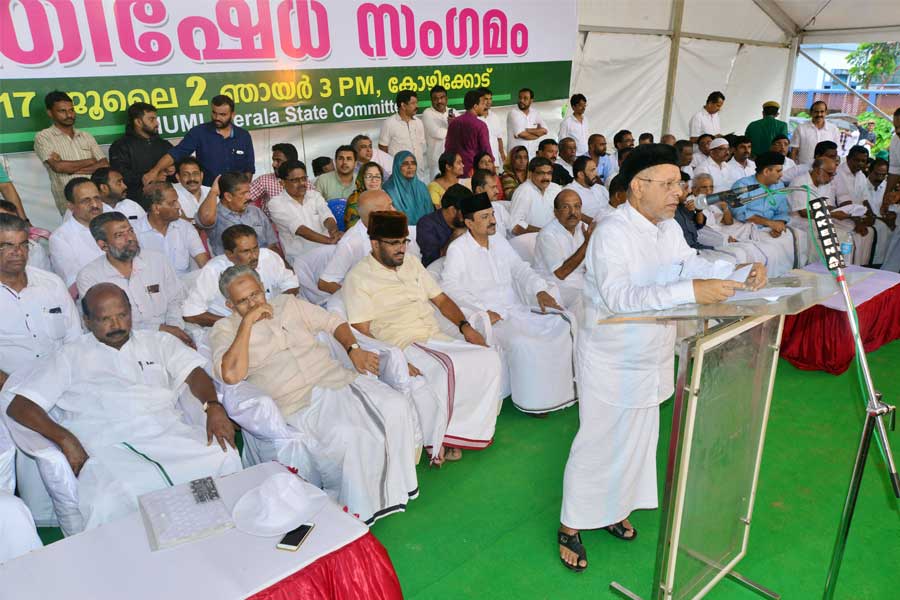
When attacks on the community became intense, mostly on charges of extremism, the party took an apologetic attitude, playing into the hands of a prejudiced state establishment and intelligence agencies. The party continued to project itself as the only bulwark against rising currents of extremism in the community. This weakened the community’s defenses against police atrocities on innocent people, often on trumped-up charges. The party remained a silent spectator as many Muslim youngsters from various parts of the state were hauled into jail, charged with Unlawful Activities Prevention Act (UAPA) and other harsh penal legislations. Many of the cases were later proved to be baseless, after long years of litigation, while the affected families were left to fend for themselves.
The rising public anger against such acts of omission and commission on the part of the Muslim League has opened a window for its rivals, including the Communists. From the late 90s, the Communist influence among the Muslim community is seen to be growing. On a parallel level, new political parties and social movements are also gaining influence in the community.
The Muslim politics is now undergoing a deep churning. This is true in the regional, national and global contexts. For the first time, the inter-linkages between all the three are unmistakably felt at the grassroots. The tremors at the national and global level are felt in the remote villages with devastating effect, and the community’s thinking, responses, cultural practices and political views are defined by the cumulative impact of all these factors. Identity is proving to be the primary marker of Muslim social and political life; religion and faith-based concerns predominant in every discourse.
The Malayali Muslim community had a unique social existence and cultural identity, with its deep roots in the historical evolution of the language and region, unique food customs, attire et al. But now, an attempt is being made to project a distinctly different image in all the outer forms of individual identity. It is a fact quite evident to any observer that the most visible trend in the community today is a more regressive and inward-looking tendency that might alienate it from its own glorious past, with serious implications for the region’s secular social fabric.
The Muslim community is now at a crossroads: It is being pulled apart by so many currents and countercurrents, arguments and counter arguments. Its social and intellectual life is vibrant, giving the impression of a society at the cusp of massive changes. But how and in what ways all these influences will transform the community and what forces and ideas will gain upper hand are things to be seen in the coming days. One thing is certain: Its politics will not remain a safe haven for vested interest groups clamouring for benefits at the expense of the community. It means the Muslim League which has held sway for so long will either lose out its preeminent position or will have to transform itself in tune with changing times.
The party is making some half-hearted efforts, and it is even talking about a larger alliance of oppressed social classes including Dalits and backward segments in the majority community. But this might not be easy, because the influence of rightwing Hindutva forces, now wielding power at the centre, is felt deeply and powerfully among the lower castes in Kerala society. On the other hand, the CPI (M) is projecting itself as the sole force that could stop Hindutva juggernaut, an argument which seems to have proven effective among sections of Muslims.
In recent years, the CPI (M) did have some success, as seen in the 2006 Assembly elections. But the League was able to regain lost ground later. The CPI (M) is also prone to taking advantage of the internal schisms in the Muslim community and encouraging retrograde social tendencies for electoral gains. Such tactics might prove counterproductive in the long run.
So, at the end of the day, it might be a new kind of politics with a deep sense of societal identity and a commitment to progressive and secular values that might get the upper hand in Muslim community in Kerala. But who will turn out to be its real champion is a moot question only time can answer.
Cover Image: The CH Mohammad Koya-led cabinet of 1979 that lasted all of two months

